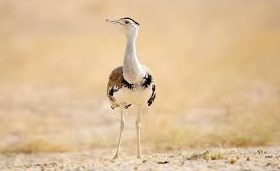NGT asks centre to prepare plan for protection of Great Indian Bustard
A National Green Tribunal (NGT) Bench headed by NGT chairperson Justice Adarsh Kumar Goel has directed Central government to prepare a time-bound action plan within two months for protection of Great Indian Bustard. This decision is in response to the high mortality rate of birds noted by NGT.
Key Highlights
Committee: NGT Bench headed by Justice A K Goel constituted a joint committee comprising officials of Union Ministry of Environment, Forest and Climate Change (MoEFCC), Ministry of Power, Ministry of New and Renewable Energy (MNRE) and nominees of Energy Departments of Gujarat and Rajasthan. The committee was tasked to prepare an action plan for implementation of suggestions put forth by Wildlife Institute of India (WII) over the isuue.
Plea: NGT was hearing a plea filed by Centre for Wildlife and Environment Litigation (CWEL), through advocate Gaurav Bansal, seeking directions to ministry to make bio-diversity impact assessment mandatory for every wind-power project, irrespective of its size/capacity. Plea stated that the reason for high mortality rate of critically endangered species of birds as per 30th Forest Advisory Committee meeting is power lines, especially high-voltage transmission lines with multiple overhead wires as the bird have poor frontal vision. It put forth that 75% of birds have died due to collision with power lines in past 30 years.
Environment Ministry also acknowledged that adult mortality among GIB is still very high due to collisions with power-lines that crisscross their flying paths.
WII Report Recommendations:
It suggested a slew of measures, such as mitigation of all power transmission lines passing through priority bustard habitats and disallowing new wind turbines, solar farms among others.
Steps should be taken to reduce poaching of specie and other wildlife in Thar landscape.
Poaching of GIB and other wildlife in Thar landscape could be reduced by improving protection enforcement through training of forest department frontline staff in smart patrolling tools with help of conservation organisations.
About Great Indian bustard
Scientific Name: Ardeotis nigriceps
Population: 200 individuals worldwide. Its largest populations are found in Indian state of Rajasthan.
Status: It is Listed in-
- Schedule I of Indian Wildlife (Protection)Act, 1972,
- Convention on Migratory Species (CMS) or Bonn Convention
- Appendix I of CITES (Convention on International Trade in Endangered Species of Wild Fauna and Flora)
- IUCN Red List- as Critically Endangered
- National Wildlife Action Plan (2002-2016)
It has also been identified as one of the species for recovery programme under Integrated Development of Wildlife Habitats of Union Ministry of Environment and Forests, and Climate Change (MoEFCC).
Month: Current Affairs - September, 2019


